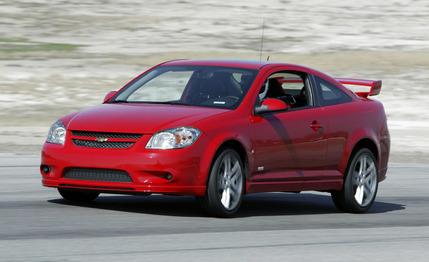
 First Drive Review
First Drive Review
Does this car look familiar? It should. Beyond the front grille treatment, the new 2008 Chevrolet Cobalt SS is visually identical to the 2005–07 Cobalt SS Supercharged. The front and rear fascias, side sills, and now-optional huge wing carry over unchanged, as does the regular Cobalt-based sheetmetal. The similarity, however, ends there.
The old SS was quite good. A mini-muscle car, it was quick in a straight line, although it became a ball of understeer when the road went bendy. But the new SS is better. Not only does it remain face-peelingly quick, but it’s also now a maniacal piece of machinery that laughs at nearly any corner you toss in front of it.
Turbos Are Super, Too
The SS Supercharged had to be discontinued because its blown four didn’t comply with emissions regulations for 2008. (The naturally aspirated imposter SS was discontinued after 2007, too; Chevy now calls that model the Cobalt Sport.) As a result, the new SS gets force-fed via an air-to-air intercooled turbocharger rather than the Eaton supercharger of the old car.
This 2.0-liter Ecotec turbo four, introduced in the Pontiac Solstice GXP and Saturn Sky Red Line roadsters, gains direct injection and variable valve timing for intake and exhaust and returns a claimed 22 mpg city and 30 mpg highway. More important, though, is that the new car puts 260 horsepower under your right foot versus 205 in the SS Supercharged. Peak torque is an impressive 260 pound-feet, and it’s available from 2000 rpm.
Chevy figures a blast to 60 ought to take 5.7 seconds, but the SS Supercharged took a mere 5.9 in our test, so we’re thinking maybe an additional 10th or two could be squeezed from the more powerful turbo model. Top speed is as high as 160 mph, so long as you forgo that ginormous, drag-heavy optional spoiler.
I’m Not Going to Break It, Am I?
Rocketing to the top end is a ridiculous amount of fun in the new SS, thanks to the standard launch control and no-lift shift functions, which are also found on the less hard-core, pudgier HHR SS. Both are fairly violent events, and not lifting off the gas when you shift feels, well, ludicrous. No-lift shifts, though, coax such sweet burbles and gunfire pops from the exhaust that you just have to do them all the time. From a stop sign? No-lift shift. Getting onto the freeway? No-lift shift. In the produce section at the grocery store? Yup, no-lift shift.
A tip from the engineers: One pop from the tailpipe is good. More pops are bad, since that means you’ve bounced it off the rev limiter and aren’t accelerating as quickly as you could. Using launch control or no-lift shifting gives you the inkling that you’re going to break the car or engine or Saab-sourced five-speed manual—or all three—in half, but Chevy warrants the powertrain for five years or 100,000 miles and says that engineers performed 600 launch-control blastoffs in a row to validate the whole shebang.
Damping and Turn-In and Braking, Oh My
Beyond the engine, though, are the chassis refinements made by the GM Performance boys. The only underbody item shared with the regular Cobalt is the front subframe. New lower control arms, control-arm bushings, 30-percent-stiffer springs, and fat 24mm front and rear solid anti-roll bars tighten the suspension like a drum skin. The steering system’s rack, electronics, and tuning are all unique to the SS, as is the car’s pedal box, which has been optimized to provide better heel-and-toe downshifts.